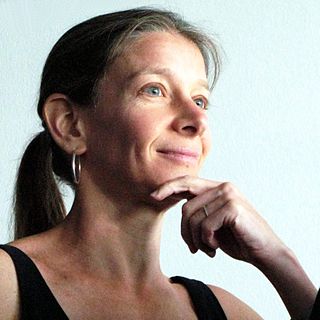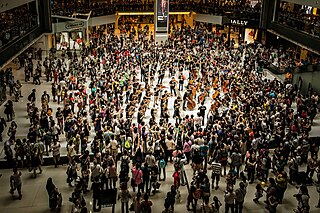General
The musician and musicologist Mícheál Ó Súilleabháin has broadly defined a music community as "a group of interested participants who agree on the form and content of the music and its social contexts". A music community may be taken to mean a group of people with strong ties who often come together to play and talk about music, but a sense of community may also come from a national educational system that connects young people to their cultural heritage and traditions.
The concept of music communities is well-developed in ethnomusicology. A large part of this discipline consists of studies of groups of people who frequently exchange and communicate musical material.
Barry Shank, writing in 1994 of Rock and roll in Austin, Texas, used the word "subculture" to define the shifting meanings and membership of musical communities, or cultural spaces. Will Straw built on this work, replacing the term "subculture" by "scene". Straw saw a "scene" as relatively transient, while a music community is more stable. He wrote in 1991 that a music community engages in "an ongoing exploration of one or more musical idioms said to be rooted within a geographically specific historical heritage." Disputing Straw's characterization, later writers have pointed out that music communities may be mobile and transient.
Musical communities typically have very flexible structures, voluntary membership and people of a wide range of ages. They offer participants the opportunity to play different roles including creator, participant or observer. Conscious efforts may be made to involve disadvantaged members. Typically the group encourages diversity, and all members are committed to lifetime learning. When a music community is widespread, aspects of music-making such as repertoire and style may evolve and diverge.
Online music communities
One of the early online music communities was established in 1996 by Oh Boy Records, a small independent record company. It took the form of a chat page on its website that let fans of John Prine exchange views and information. The website became the base of a specialized Prine music community. However, as Prine ceased performing while fighting cancer, and no new recordings were released, the community ran out of information to exchange and went into decline. Oh Boy eventually closed the chat page.
Another early online music community that was the subject of an ethnographic study was the Banjo Hangout, established in 2000. As of 2011 it had about 51,000 members and featured a large online learning center.
imeem, a social networking site with 28 million monthly visitors, was the first music community to provide ad-supported free online music streaming and downloading. Other sites such as Myspace followed with similar services. Specialized software has been developed to support online music communities.
Online communities have emerged for genres of folk music such as Blue Grass and Old Time. Cyber-ethnography using the framework of Étienne Wenger's social learning theory shows that sites like this may be considered a community of practice (CoP). The members of an online music community can publish, listen to and evaluate the music they have created, giving them a strong sense of membership. It provides a platform within which members can create a musical identity as well as one in which they can build social bonds. J. P. Williams, writing in 2006 in the Journal of Contemporary Ethnography , argued that the driving force behind online music communities is the interest of the participants in building their identities, despite the ostensible focus on making and sharing music. [25] [26]
A 2013 book notes that in Finland the Mikseri music portal, with about 140,000 registered users, helps people create, share and discuss their music in this sparsely-populated country. This web-based community was the object of ethnographic studies in 2008 and 2009 based on theories of sociocultural learning. Members of Mikseri do not exclusively belong to that community, but may belong to other real-world or online communities. An analysis of event-related data from an online music community shows that events on that site often cause increased interest in a given artist, but propagation over links within digital social communities is also an important factor. An investigation of the music community of fans of Swedish indie music showed that they do not gather around one site, but interact with a network of sites including their own fan sites, Myspace, Last.fm, YouTube and so on.
Online discussion forums may provide some of the functions of virtual music communities. However, according to Mary McCarthy a music community should teach uninitiated listeners or musicians, and an online group cannot fill this role. Only a community of real people in a real place can provide the depth of contact, discussion, sharing and support that the novice musician requires for their development.
Vampr is a social network app for people in the music industry to discover, connect and build a community of other like-minded musicians and professionals. With a userbase of over 1,000,000 users, it's currently the number 1 network platform for musicians.
Musicology is the scholarly analysis and research-based study of music. Musicology departments traditionally belong to the humanities, although some music research is scientific in focus. Some geographers and anthropologists have an interest in musicology so the social sciences also have an academic interest. A scholar who participates in musical research is a musicologist.

Ethnomusicology is the study of music from the cultural and social aspects of the people who make it. It encompasses distinct theoretical and methodical approaches that emphasize cultural, social, material, cognitive, biological, and other dimensions or contexts of musical behavior, in addition to the sound component.

A counterculture is a culture whose values and norms of behavior differ substantially from those of mainstream society, sometimes diametrically opposed to mainstream cultural mores. A countercultural movement expresses the ethos and aspirations of a specific population during a well-defined era. When oppositional forces reach critical mass, countercultures can trigger dramatic cultural changes. Prominent examples of countercultures in the Western world include the Levellers (1645–1650), Bohemianism (1850–1910), the more fragmentary counterculture of the Beat Generation (1944–1964), followed by the globalized counterculture of the 1960s (1964–1974).

Ethnography is a branch of anthropology and the systematic study of individual cultures. Ethnography explores cultural phenomena from the point of view of the subject of the study. Ethnography is also a type of social research that involves examining the behaviour of the participants in a given social situation and understanding the group members' own interpretation of such behaviour.
An online community, also called an internet community or web community, is a community whose members interact with each other primarily via the Internet. Members of the community usually share common interests. For many, online communities may feel like home, consisting of a "family of invisible friends". Additionally, these "friends" can be connected through gaming communities and gaming companies. Those who wish to be a part of an online community usually have to become a member via a specific site and thereby gain access to specific content or links.

A Veblen good is a type of luxury good for which the demand for a good increases as the price increases, in apparent contradiction of the law of demand, resulting in an upward-sloping demand curve. The higher prices of Veblen goods may make them desirable as a status symbol in the practices of conspicuous consumption and conspicuous leisure. A product may be a Veblen good because it is a positional good, something few others can own.

Internet culture, or cyberculture, is the culture based on the many manifestations of the use of computer networks for communication, entertainment, business, and recreation. Some features of Internet culture include online communities, gaming, social media, and more, as well as topics related to identity and privacy. Due to the internet's large scale use and adoption, the impacts of internet culture on society and non-digital cultures have been widespread. Additionally, due to the all encompassing nature of the internet and internet culture, different facets of internet culture are often studied individually rather than holistically, such as social media, gaming, specific communities, and more.
Women's studies is an academic field that draws on feminist and interdisciplinary methods in order to place women's lives and experiences at the center of study, while examining social and cultural constructs of gender; systems of privilege and oppression; and the relationships between power and gender as they intersect with other identities and social locations such as race, sexual orientation, socio-economic class, and disability.

Judith Stefania Donath is a fellow at Harvard's Berkman Center, and the founder of the Sociable Media Group at the MIT Media Lab. She has written papers on various aspects of the Internet and its social impact, such as Internet society and community, interfaces, virtual identity issues, and other forms of collaboration that have become manifest with the advent of connected computing.
A social networking service or SNS is an online platform which people use to build social networks or social relationships with other people who share similar personal or career content, interests, activities, backgrounds or real-life connections.
Digital anthropology is the anthropological study of the relationship between humans and digital-era technology. The field is new, and thus has a variety of names with a variety of emphases. These include techno-anthropology, digital ethnography, cyberanthropology, and virtual anthropology.
Online ethnography is an online research method that adapts ethnographic methods to the study of the communities and cultures created through computer-mediated social interaction. As modifications of the term ethnography, cyber-ethnography, online ethnography and virtual ethnography designate particular variations regarding the conduct of online fieldwork that adapts ethnographic methodology. There is no canonical approach to cyber-ethnography that prescribes how ethnography is adapted to the online setting. Instead individual researchers are left to specify their own adaptations. Netnography is another form of online ethnography or cyber-ethnography with more specific sets of guidelines and rules, and a common multidisciplinary base of literature and scholars. This article is not about a particular neologism, but the general application of ethnographic methods to online fieldwork as practiced by anthropologists, sociologists, and other scholars.
A community of practice (CoP) is a group of people who "share a concern or a passion for something they do and learn how to do it better as they interact regularly". The concept was first proposed by cognitive anthropologist Jean Lave and educational theorist Etienne Wenger in their 1991 book Situated Learning. Wenger then significantly expanded on the concept in his 1998 book Communities of Practice.

An ethnoreligious group, or simply an ethnoreligion, is a grouping of people who are unified by a common religious and ethnic background.

Sociomusicology, also called music sociology or the sociology of music, refers to both an academic subfield of sociology that is concerned with music, as well as a subfield of musicology that focuses on social aspects of musical behavior and the role of music in society.

Wikiversity is a Wikimedia Foundation project that supports learning communities, their learning materials, and resulting activities. It differs from Wikipedia in that it offers tutorials and other materials for the fostering of learning, rather than an encyclopedia; like Wikipedia, it is available in many languages.
Netnography, is a specific type of qualitative social media research. It adapts the methods of ethnography, is understanding social interaction in contemporary digital communications contexts. You can think of netnography as a particular set of actions for doing research within and about social media.Netnography is a specific set of research practices related to data collection, analysis, research ethics, and representation, rooted in participant observation. In netnography, a significant amount of the data originates in and manifests through the digital traces of naturally occurring public conversations recorded by contemporary communications networks. Netnography uses these conversations as data. It is an interpretive research method that adapts the traditional, in-person participant observation techniques of anthropology to the study of interactions and experiences manifesting through digital communications.

David Williamson Shaffer is the Vilas Distinguished Achievement Professor of Learning Science at the University of Wisconsin–Madison in the department of Educational Psychology, the Obel Foundation Professor of Learning Analytics at Aalborg University in Copenhagen, a Data Philosopher at the Wisconsin Center for Education Research, and Principal of EFGames, LLC.
David G. Hebert is a musicologist and comparative educationist, employed as Professor of Music at Western Norway University of Applied Sciences, where he leads the Grieg Academy Music Education (GAME) research group. He has contributed to the fields of music education, ethnomusicology, sociomusicology, comparative education, and East Asian Studies. Since 2018, he has been manager of the Nordic Network for Music Education, a multinational state-funded organization that sponsors intensive Master courses and exchange of university music lecturers and students across Northern Europe. He is also a visiting professor in Sweden with the Malmo Academy of Music at Lund University, and an honorary professor with the Education University of Hong Kong. He has previously been sponsored by East Asian governments as a visiting research scholar with Nichibunken in Kyoto, Japan, and the Central Conservatory of Music, in Beijing, China.

Learning to Labour: How Working Class Kids Get Working Class Jobs is a 1977 book on education, written by British social scientist and cultural theorist Paul Willis. A Columbia University Press edition, titled the "Morningside Edition," was published in the United States shortly after its reception.











